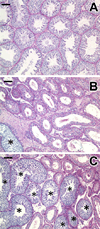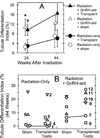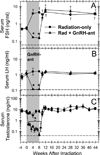Hormone suppression with GnRH antagonist promotes spermatogenic recovery from transplanted spermatogonial stem cells in irradiated cynomolgus monkeys
- PMID: 24124124
- PMCID: PMC3889638
- DOI: 10.1111/j.2047-2927.2013.00126.x
Hormone suppression with GnRH antagonist promotes spermatogenic recovery from transplanted spermatogonial stem cells in irradiated cynomolgus monkeys
Abstract
Hormone suppression given before or after cytotoxic treatment stimulates the recovery of spermatogenesis from endogenous and transplanted spermatogonial stem cells (SSC) and restores fertility in rodents. To test whether the combination of hormone suppression and transplantation could enhance the recovery of spermatogenesis in primates, we irradiated (7 Gy) the testes of 12 adult cynomolgus monkeys and treated six of them with gonadotropin-releasing hormone antagonist (GnRH-ant) for 8 weeks. At the end of this treatment, we transfected cryopreserved testicular cells with green fluorescent protein-lentivirus and autologously transplanted them back into one of the testes. The only significant effect of GnRH-ant treatment on endogenous spermatogenesis was an increase in the percentage of tubules containing differentiated germ cells (tubule differentiation index; TDI) in the sham-transplanted testes of GnRH-ant-treated monkeys compared with radiation-only monkeys at 24 weeks after irradiation. Although transplantation alone after irradiation did not significantly increase the TDI, detection of lentiviral DNA in the spermatozoa of one radiation-only monkey indicated that some transplanted cells colonized the testis. However, the combination of transplantation and GnRH-ant clearly stimulated spermatogenic recovery as evidenced by several observations in the GnRH-ant-treated monkeys receiving transplantation: (i) significant increases (~20%) in the volume and weight of the testes compared with the contralateral sham-transplanted testes and/or to the transplanted testes of the radiation-only monkeys; (ii) increases in TDI compared to the transplanted testes of radiation-only monkeys at 24 weeks (9.6% vs. 2.9%; p = 0.05) and 44 weeks (16.5% vs. 6.1%, p = 0.055); (iii) detection of lentiviral sequences in the spermatozoa or testes of five of the GnRH-ant-treated monkeys and (iv) significantly higher sperm counts than in the radiation-only monkeys. Thus hormone suppression enhances spermatogenic recovery from transplanted SSC in primates and may be a useful tool in conjunction with spermatogonial transplantation to restore fertility in men after cancer treatment.
Keywords: gonadotropin-releasing hormone-antagonist; infertility; radiation; spermatogenesis; transplantation.
© 2013 American Society of Andrology and European Academy of Andrology.
Conflict of interest statement
The authors have no conflicting financial interests.
Figures






Similar articles
-
Restoration of functional sperm production in irradiated pubertal rhesus monkeys by spermatogonial stem cell transplantation.Andrology. 2020 Sep;8(5):1428-1441. doi: 10.1111/andr.12807. Epub 2020 May 18. Andrology. 2020. PMID: 32351003 Free PMC article.
-
Effect of hormone modulations on donor-derived spermatogenesis or colonization after syngeneic and xenotransplantation in mice.Andrology. 2019 Mar;7(2):257-265. doi: 10.1111/andr.12571. Epub 2018 Nov 23. Andrology. 2019. PMID: 30471208 Free PMC article.
-
Postpubertal spermatogonial stem cell transplantation restores functional sperm production in rhesus monkeys irradiated before and after puberty.Andrology. 2021 Sep;9(5):1603-1616. doi: 10.1111/andr.13033. Epub 2021 Jul 7. Andrology. 2021. PMID: 33960147 Free PMC article.
-
Hormonal approaches to preservation and restoration of male fertility after cancer treatment.J Natl Cancer Inst Monogr. 2005;(34):36-9. doi: 10.1093/jncimonographs/lgi002. J Natl Cancer Inst Monogr. 2005. PMID: 15784820 Review.
-
Suppression of testosterone stimulates recovery of spermatogenesis after cancer treatment.Int J Androl. 2003 Jun;26(3):141-6. doi: 10.1046/j.1365-2605.2003.00400.x. Int J Androl. 2003. PMID: 12755992 Review.
Cited by
-
Molecular and cellular profiling of acute responses to total body radiation exposure in ovariectomized female cynomolgus macaques.Int J Radiat Biol. 2015 Jun;91(6):510-8. doi: 10.3109/09553002.2015.1028597. Epub 2015 Apr 22. Int J Radiat Biol. 2015. PMID: 25786585 Free PMC article.
-
Differentiation of primate primordial germ cell-like cells following transplantation into the adult gonadal niche.Nat Commun. 2018 Dec 17;9(1):5339. doi: 10.1038/s41467-018-07740-7. Nat Commun. 2018. PMID: 30559363 Free PMC article.
-
Oncofertility: Pharmacological Protection and Immature Testicular Tissue (ITT)-Based Strategies for Prepubertal and Adolescent Male Cancer Patients.Int J Mol Sci. 2019 Oct 21;20(20):5223. doi: 10.3390/ijms20205223. Int J Mol Sci. 2019. PMID: 31640294 Free PMC article. Review.
-
Granulocyte colony-stimulating factor prevents loss of spermatogenesis after sterilizing busulfan chemotherapy.Fertil Steril. 2015 Jan;103(1):270-80.e8. doi: 10.1016/j.fertnstert.2014.09.023. Epub 2014 Nov 5. Fertil Steril. 2015. PMID: 25439845 Free PMC article.
-
Models and Methods for Evaluating Regeneration of Spermatogenesis After Cytotoxic Treatments.Methods Mol Biol. 2023;2656:239-260. doi: 10.1007/978-1-0716-3139-3_14. Methods Mol Biol. 2023. PMID: 37249876
References
-
- Anserini P, Chiodi S, Spinelli S, Costa M, Conte N, Copello F, Bacigalupo A. Semen analysis following allogeneic bone marrow transplantation. Additional data for evidence-based counselling. Bone Marrow Transplant. 2002;30:447–451. - PubMed
-
- Boekelheide K, Schoenfeld H, Hall SJ, Weng CCY, Shetty G, Leith J, Harper J, Sigman M, Hess DL, Meistrich ML. Gonadotropin-releasing hormone antagonist (cetrorelix) therapy fails to protect non-human primates (macaca arctoides) from radiation-induced spermatogenic failure. J Androl. 2005;26:222–234. - PubMed
-
- Dobrinski I, Ogawa T, Avarbock MR, Brinster RL. Effect of the GnRH-agonist leuprolide on colonization of recipient testes by donor spermatogonial stem cells after transplantation in mice. Tissue Cell. 2001;33:200–207. - PubMed
-
- Herbst KL. Gonadotropin-releasing hormone antagonists. Curr Opin Pharmacol. 2003;3:660–666. - PubMed
Publication types
MeSH terms
Substances
Grants and funding
LinkOut - more resources
Full Text Sources
Other Literature Sources

